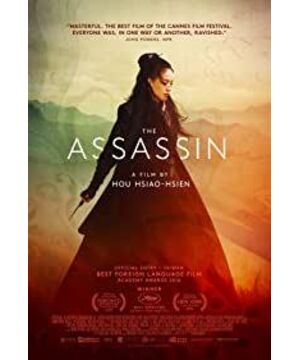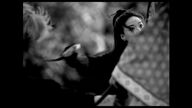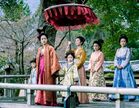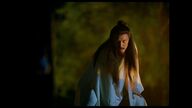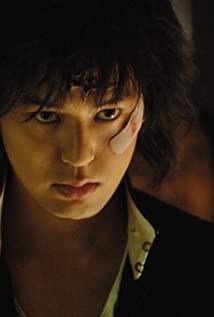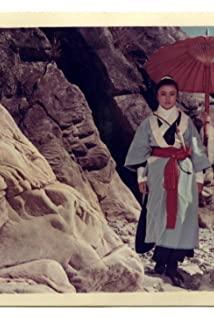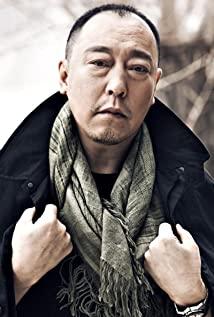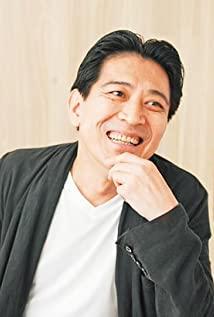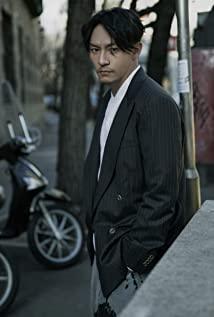It's a good time to watch a movie and meet "Nie Yinniang", too.
Finally saw a genuine art film. I have learned a lot of interpretations, some say that it is a metaphor for Taiwan's reality and history, some say that it elucidates the subtlety of martial arts, some says that it is about comprehending the Buddhist Dharma and Zen, and some say that Nie Yinniang is the Oriental Mona Lisa... Everyone is right, art films should be Interpretation, no matter how you interpret it, is not excessive. In a sense, this is even the only way to measure the "authenticity" of art films. "Pseudo-art films", a little bit of interpretation of something new, is far-fetched. Unlike "Nie Yinniang", the real art films are all in the wine, and they are not in the wine. Of course, the production of meaning is a complex relationship with the work itself, and it is basically a hermeneutics problem. I have always used the book "Interpretation and Over-Interpretation" as a guideline, so I won't go into details here, otherwise I'll have to fork out a long paragraph. go.
From the "spirit splicing method" to the "cloud block splicing method", Hou Ye is still anti-commercial as always. The word "art film" is used here. There is no way. The everyday language is simple and rude, but it is also easy to use. The famous funny website Zhihu has also explained the terms of "artistic film" and "artistic film" in a serious manner, which really has nothing to say. Of course, there is still a large-scale usage of "literary film" in film history, but it is not in the context of "Nie Yinniang" referred to in this article, so I won't go into details here, otherwise it will be a long paragraph.
The frame has changed, the color has changed, and the graininess has also appeared. The filmmaker explained that it was not a technical fault. "(Contemporary) art is just fooling around." No matter how you play it, you can interpret it to make up for it. I think one of the main reasons is that it took seven or eight years of filming. In addition to tossing and coordinating the scene, it is difficult to ensure the uniformity of the format when the technical standards are changing with each passing day. However, it is very good in the overall mood of the film, so there is no need to care. . It must be explained with ingenuity. Lord Hou said it himself, and nothing else is mentioned. Of course, the boundary between contemporary and postmodern art is a very complicated issue, and its relationship with film is also complicated. I just give a general idea, so I won't go into details here, otherwise I'll have to fork out a long paragraph.
The title of "Nie Yinniang" is "Assassin Nie Yinniang", isn't it martial arts? That's right, in "Eternal Literati's Dream of Knights", the legend of Tang Dynasty is regarded as an important source of martial arts. Lu Xun said in "A Brief History of Chinese Fiction": "Pei Jing wrote a book, and it is called "Legend"...Nie Yinniang Shengmiao published this book empty-handed." Baidu Encyclopedia also said that "Nie Yinniang" was written by Pei Jing. , but now the academic world has begun to favor Yuan Jiao as the author, so leave him alone. Anyway, it was the late Tang Dynasty, and the imperial court tried to calm down the Anshi Rebellion, and also buried the bane of the separatism of the feudal towns. Of course, the story of the movie cannot be equated with specific historical facts, and it is also different from the original work of Tang Legend, so I won't repeat it here, otherwise it will be a long paragraph.
Shu Qi said that the movie "Nie Yinniang" is "love, fighting and a lonely woman", I thought it was very good. Zhu Tianwen said that films like "Nie Yinniang" should be treated with great kindness and empathy. Modern society is irritable, and you will get dry at every move. If you are in the mood to watch "Nie Yinniang", the light and shadow change in an instant, a cloud, a ray of light, and a shadow shine on the pork (this is an allusion of Hou Ye, and I won't repeat it here. It’s very interesting, and it’s more interesting than the boring stuff. Of course, I also think “Mad Max” is interesting, but it’s not as interesting as “Nie Yinniang”. The specific comparison of the two films is here. I won't go into details, otherwise I'll have to fork out a long paragraph.
The ending song Rohan is the product of the cooperation between the French band Bagad Men Ha Tan and African drummers. Bagad means the band. This song is included in the album Dakar. Dakar is the capital of Senegal and the hometown of the drummers. Rohan set off in the backs of Nie Yinniang and the mirror-grinding boy, and I heard the ancient rhyme of Tang style while writing the subtitles. I think it has something to do with the world influence of the Tang Empire. Chen Yinke said that the Tang Empire was established by the "Guanlong Group". Hu Feng was blowing, and the ethnic groups were integrated. The emperor was Tian Khan. Tian Ji'an watched Hu Wu marry Hu Ji in the movie. At that time in Chang'an, there were more black people than there are in Guangzhou now. It is a world empire, and there is no sense of disobedience to world music. However, this song reminds me of the feeling of the medieval folk songs of Tmlhbac. Maybe in ancient society, everyone has something in common, or because modern society has really become the meaning of Strauss" A generally homogeneous country”, the convergence is serious, and when you hear the classical flavors of exotic flavors, you feel completely different from your ears. Of course, the issue of the dispute between the ancients and the modern will not be repeated here, otherwise it will be a long paragraph.
I also played the drums, because there was little music, and there were a lot of ambient sounds, birds, the wind passing through the forest, some insects, and then there were drums. I am obsessed with the sound of the drums. Guzheng (guqin?) is also good. Guzheng is Chinese, but the drums are not good. In the original music, drums were used, and the drums were psychic. Wunuo shamans all played tambourines, which was a bit like the drum in Rohan, so the drum sound in "Nie Yinniang" seemed to be psychic, with the meaning of the sound of nature. In the past, there was a text written by Lu Dingyi in the textbook, he was lying in the field (like the Long March), "There are incomprehensible sounds in his ears, the very far and the very close, the very big and the very finely sliced. Like spring silkworms chewing mulberry leaves, like wild horses galloping on the plain, like mountain springs whimpering, like waves surging.” The drums and other sound effects in "Nie Yinniang" gave me this rush. It's very mysterious and makes you feel very small. Of course, I haven't verified the specific role of drums in the original music, so I won't go into details here, otherwise I'll have to fork out a long paragraph.
Bagpipes, double reeds and drums, what use is Hu Xuan dance? Some netizens said it was a suona, and yes, it was a Brittany suona. These sounds are very old-fashioned. Ancient is difficult, not drums have ancient meanings, you see "Booming Drummer", the meaning is the opposite. "Nie Yinniang" really captures the ancient meaning, the situation of the ancients, the thoughts of the ancients, the anger of the ancients. Of course, they are all fake and true ancient meanings, such as movies, dialogues, all history is contemporary history, just narrating history, ancient is also ancient in vernacular, and cannot be understood rigidly. The analysis of the ancient meaning will not be repeated here, otherwise it will be a long paragraph.
In the original work, Nie Yinniang was kidnapped by a nun, and in the movie she was a Taoist nun. Tang Huang Chongdao, the old Li family, the channel to teach immortals, the affiliated association is always inevitable. Taoist nuns in the Tang Dynasty are very magical. For example, Yu Xuanji, Shigeru Saito wrote "The Literati and the Prostitute". When talking about the Tang Dynasty, he said that many nuns had flesh and blood business. Well, this is not about the nuns in the movie, but that Tao nuns were in Tang Dynasty. Dynasty, it's very mysterious, the princess deserves it, and the prostitute deserves it - or vice versa? The young man who wears mirror, played by his wife and husband Mu Cong, speaks a little Japanese, and also says that he will go to Xinluo Yunyun, and the mirror has a close relationship with Taoism. In the original work, the mirror-grinding boy was the husband-in-law chosen by Yin Niang herself, and his parents would not dare to follow. The movie didn't mean that, but probably meant that. Anyway, the matter of Buddhism and Taoism has always been entangled in the meaning and theory, so I won't go into details here, otherwise it will be a long paragraph.
Nie Yinniang is lonely, "a person has no peers", the whole "Nie Yinniang" is lonely, and I haven't seen a lively one. After dancing the Hu Xuan Dance, it was considered a lively moment, and he was immediately targeted by the Phantom Killer, which made him sad. The practice of paper figurines is very common in Tang legends, and even more strange in the original work of "Nie Yinniang", origami is a donkey, and a knife is hidden behind the head (fortunately Paul Verhoeven didn't see this, otherwise he would feel that his "Comprehensive Recall" "Painted in vain), turned into mosquitoes and sneaked into the intestines (comparable to the return of the great sage), Yinniang's skills, all-purpose. When it was made into a movie, Lord Hou was still restrained, the relationship between the characters was also changed, and there were more love entanglements. The similarities and differences between the specific adaptations will not be repeated here, otherwise a long paragraph will be forked.
Movies are imported from abroad, and their basic style, grammar, and artistic features are Western, with very little Chinese characteristics. Therefore, "Nie Yinniang" is rare. Fei Mu's "Spring in a Small Town" has Chinese aesthetic characteristics, and so is "Nie Yinniang." Hou Ye said that he wanted to shoot Fu Baoshi on the big screen (Bing Ge started, Hou Ye tends to be realistic rather than freehand, I don’t agree with it all, but the tonality of the film and painting is still Fu Baoshi), I thought it was filmed. The picture is like a Chinese painting. This is very, very powerful. It is much more powerful than the oil painting, and it has a "realm", the "realm" that Wang Guowei said. Some people say that it is the realm of "empty mountains do not see people, but hear people's voices", which is a bit interesting. Like the aforementioned voice, it makes you feel very small. Of course, Hu Jinquan has also filmed a similar one before. Spiritual rain falls from empty mountains, and there are legends in the mountains, but the most similar one is "Chivalrous Girl". "Liao Zhai" and the legend of Tang Dynasty, the original, the movie, are similar, and also like Kurosawa Akira, of course, it can be sorted out from the sequence of Hou Ye's own works, but it is too simple, and it does not show my brilliance. I won't go into details, otherwise I'll have to fork out a long paragraph.
"Nie Yinniang" is a film made by people who understand it, and this is also an important criterion for a true art film. One step away, where is far away? The Taoist priest goes down the mountain, what are you doing down the mountain? If you don't want to understand it, it's fake. It's not fake, at least it's wilted. "Nie Yinniang" is transparent, just like Lin Qingxia said to Zhang Manyu in "New Dragon Inn": "Then you have to let me see you a little more transparently", "Nie Yinniang" is facing the audience, that's it. Clear, natural and transparent. Art films have to wait, wait for the clouds to arrive, wait for the wind to come, wait for the stomach to be hungry, and people who understand can wait. When you go to see "Nie Yinniang", you also wait, wait for the end of a period of time, wait for the lights to brighten, and wait for the sound of Rohan. Alas, that's not exactly what I've said, but it's too tedious to explain clearly, so I won't go into details here, otherwise I'll have to fork out a long paragraph.
Some people say that talking about the love of this film will cut off friends in the circle of friends, why bother, that is not understood. The movie is originally a radish and cabbage. It is a movie to make friends. There is no one of the same kind. If you find someone you like, you will have it. How wonderful. A good art film is like a marriage. It’s good to meet the right person at the right time. Forget the box office, "Nie Yinniang" is immune to that thing. If you don't like to watch it, then it doesn't matter what he is. Just like my article, looking for readers is also looking for a marriage. If there is a beautiful woman who happens to have a similar rush to me, then I will be very happy. If she has big breasts, it will be even better. Of course, I don't mean to make an offer, but I just use an analogy.
When the weather is cool, it's a good time to watch "Nie Yinniang". But I'm not talking about the weather, so I won't go into details here, otherwise I'll have to fork out a long paragraph.
View more about The Assassin reviews


